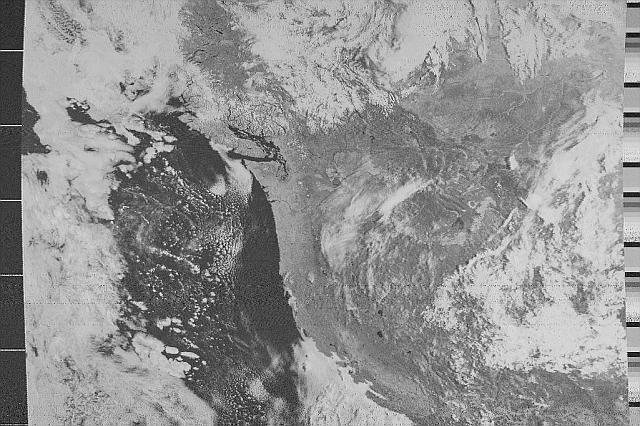Pictures from Above
...or, a Pentium is a nice thing to have.
I've been playing around with this stuff for some time. My first experiments
with weather satellites used external hardware, an interface that rectified
the APT subcarrier, low-pass filtered the proceeds and then digitized them
to be pulled into the computer's parallel port and processed by a program
like JVFax. This worked, but then I got curious about my computer's sound
card...
My first program was the classic digital crystal set AM detector: rectify
and low-pass filter. It actually worked well. But I've continued playing
and trying things, and am now getting pretty good pictures. Here's one
of B.C., now that I'm back on the west coast:

...and here's a picture from when I was at school in Toronto:

My current software uses a complex AM detector and an LMS adaptive filter
for noise reduction. I claim no originality for any of the algorithms.
They're all covered in standard DSP textbooks.
There are a couple of different standards for sending images. Both use
a nominal 2400 Hz AM subcarrier.
| The format used by the U.S. NOAA satellites is 240
lines per minute, with alternating visible and infrared scans. This sample
is from NOAA-14.
The "tick-tock" effect is the sync pulses. The beginning of the visible
scan is a burst of 1040 Hz ("tick"), while the beginning of the IR scan
is 832 Hz ("tock"). |


|
| The older satellites launched by the Soviet Union and the newer
ones launched by the CIS send 120 line per minute IR imagery only. The
"tunk" sound is the sync pulses. This sample is from Resurs 01-N4.
Older satellites like Meteor 3-5 had a higher-frequency subcarrier,
closer to 2500 Hz. The newer ones seem to be spot on 2400 Hz. |


|
All the signal processing is in floating point. Pentiums do it well: reading
from a file, my program processes 280,000 samples per second on
a 550 MHz Pentium 3, up from the 80,000 the old Pentium 233 MMX did.
Hardware and stuff
For an application like this you actually want the cheapest, nastiest
sound card you can find. The cheapest card will record everything there
is to record from a communications-grade audio channel with ease. Additionally,
expensive cards have all those 3D surround effects and similar junk, which
may make shoot-'em-up computer games sound better, but which raise hell
with the amplitude and phase response that us DSP hacks work so hard to
get right.
The hardware of my VHF APT weather satellite system is:
-
Home-made crossed-dipole antenna.
-
Home-made dual-gate MOSFET (BF961) preamp, essentially the front end of
the Suffolk 2 meter transverter.
-
Modified Realistic (i.e. Radio Shack) Pro-43 scanner, with the 455 kHz
IF filter replaced by a capacitor.
-
Home-made Linux software with complex AM detection and LMS noise reduction.
Written with Gnu C and the SGI TIFF libary.
-
I now use GIMP for all the image post-processing: resizing, cropping, playing
with the gamma curve, and so on.
-
550 MHz Pentium 3 system to run all this stuff on. Gross overkill, but
it was cheap. :-)
I want more!
Here are some links that might be useful:
-
The terminally curious can find APT specifications
here.
-
This is NOAA's main jumping-off
point for weather satellite intormation.
-
The Remote Imaging Group in England
has links to software, hardware information and lots more.
-
You can get satellite tracking software from AMSAT.
-
You can get Keplerian elements for your tracking software from Celestrak.
I plan no further APT development. It's time to get serious: HRPT. I've
started on a receiver and am considering how to process the bit stream.
Back to Laura's web page.


